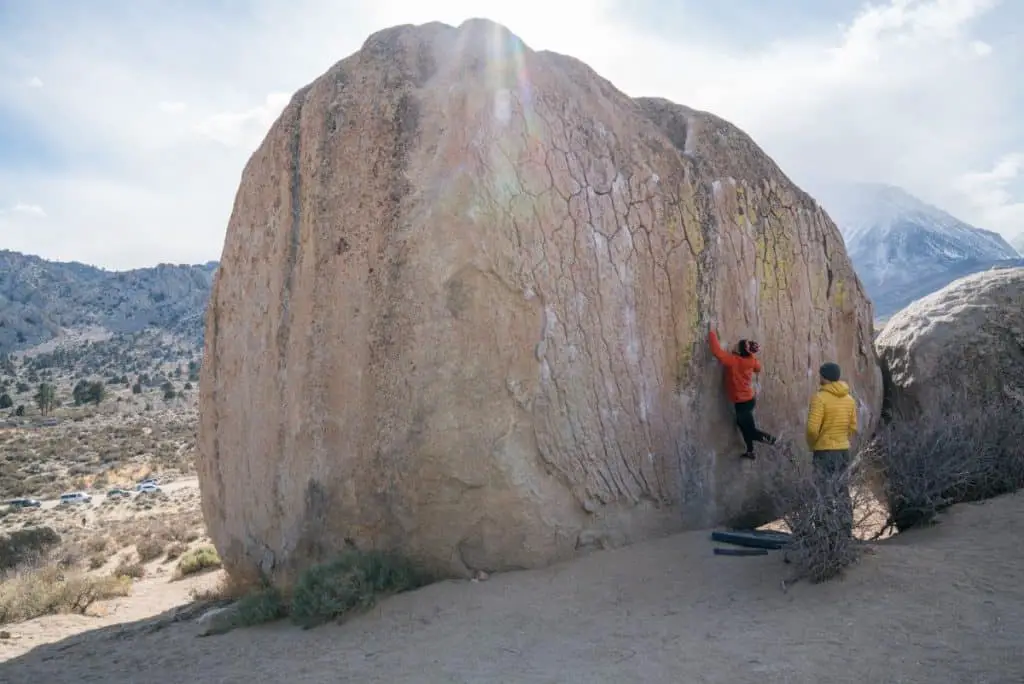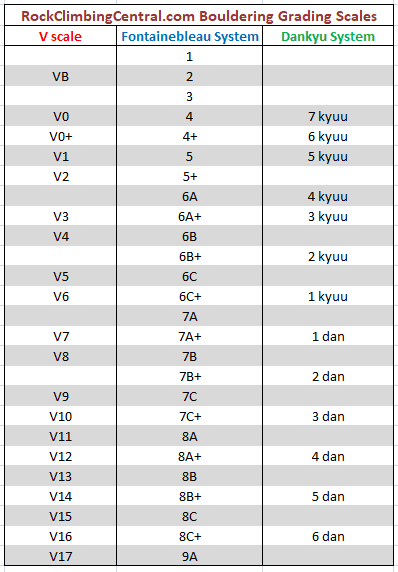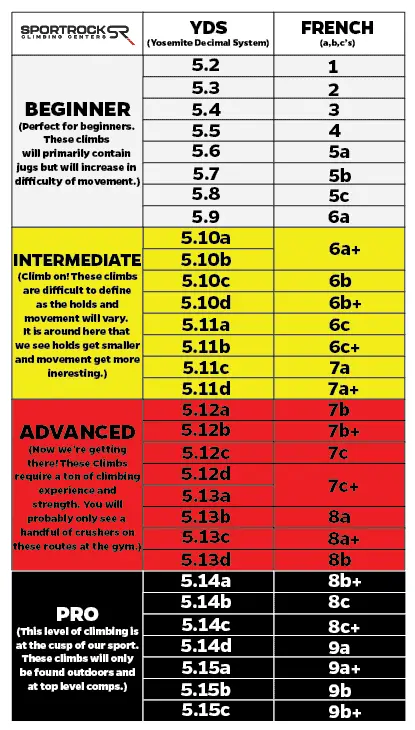
If you’re still new to climbing, you may assume rock climbing and bouldering are the same. What if I told you that you’re wrong? Even though these two activities are closely related, they’re two different beasts with different levels of complexity. In this article, we will go through the different levels of complexity between rock climbing and bouldering, and how one compares to the other. But before we discuss how these two climbing activities differ, let’s find out which one is harder and why.
So, is bouldering harder than rock climbing? Beginners usually find rock climbing / roped climbing harder than bouldering because of the addition of height and need for extra muscular endurance. However, bouldering is completely different to rock climbing due to the grading and several other reasons. Therefore it is impossible to say which one is harder than the other. First, bouldering involves climbing rocks using a small amount of gear. All you need is chalk and shoes and maybe some crash pads, whereas rock climbing usually involves other gear such as ropes, harnesses, slings, shoes, chalk, carabiners etc. Bouldering is a more robust and dynamic activity, which makes it only suitable for strong people with flexible bodies, whereas rock climbing requires more muscular endurance.
The safety aspects of both activities also differs – with rock climbing you have to focus on clipping in correctly as you advance, and with bouldering you want to fall onto the mat correctly. To find out the dangers of clipping incorrectly, check out my backclipping article.
Rock climbing is also more enduring and easier on the joints, which makes it good for older people and individuals with weak physiques. Bouldering can be compared to sprinting or completing a 400-meter race. It’s short, quick, and very tough. On the contrary, rock climbing is more like a marathon race; you can take your time, slow down when you feel worn out, and eventually complete the task at your own pace.
Page Jumps
- What is Rock Climbing?
- What is Bouldering?
- The Grading of Bouldering and Rock Climbing
- Reasons Why Bouldering is Different to Rock Climbing
- Does Bouldering Improve Your Rock Climbing Skills?
- Does Rock Climbing Help Bouldering?
- Should You Do Rock Climbing and Bouldering?
What is Rock Climbing?
Rock Climbing is a physical sport that involves climbing up natural rock formations using ropes and specialized equipment to reach the top. Rock climbing can also be done on man-made rock walls with pre-determined routes.
Rock Climbing is a mentally and physically demanding activity, and one requires balance, strength, agility, and mental control to be a successful climber. If done without proper knowledge, technique, and equipment, rock climbing can be very dangerous. Below is an overview of the most common types of rock climbing.
Top rope climbing – This is the first type of climbing most people learn. Top rope climbing is the easiest and the least dangerous, making it ideal for amateur climbers. Here, the climber is tied to a rope that is fastened to an anchor point at the top of the rock and back down to a person on the ground who’ll hold the climber’s in case of a fall. In top rope climbing, the rope is always above, reducing the chances of getting injured in the event of a fall.
Lead climbing – After you’ve mastered the basics of safety and climbing, you can proceed to lead climbing. Lead climbing requires a mental commitment because your rope will be tied to your harness, and will trail along as you climb. The other end of the will be fed to a belay device. If you happen to fall, the belayer will use the belay device to slow/stop the fall. Unlike top-roping, there’s a possibility of a real fall. The two types of lead climbing are sport and trad (traditional) climbing.
Indoor climbing – Indoor climbing (which is usually top roping but indoors) is also very popular. In indoor climbing, you have a safe, climate-controlled, and well-structured environment. Most indoor climbing facilities offer different types of bouldering and climbing. They also have rental equipment, structured activities, and lessons. Indoor climbing can be used to learn the fundamentals needed for outdoor climbing as well.
What is Bouldering?
Bouldering, derived from the word “boulder,” is a form of climbing that involves climbing up to a jump height without a harness or a rope. Most sportspeople love this activity because it helps them to exceed their performance limits. It allows individuals to train quickly and flexibly within relatively less time.
You can also do it on your own because it doesn’t require a climbing partner to help belay. Bouldering perfectly enhances your coordination and mobility. Since you’re very close to the ground, there’s no rope to catch you if you fall. Instead, pads are used to reduce the impact.
For more information on all aspects of bouldering, go to my Bouldering 101 article.
The Grading of Bouldering and Rock Climbing
Most individuals think that the grading of these two disciplines is the same, which isn’t the case. We have different grading systems in different parts of the world for bouldering and for other different types of rock climbing.
Bouldering Grading
Bouldering has five different grading systems:
- The V scale aka The Hueco Scale is the most used system in North America which includes gradings from V0-V17.
- The B system is used in North America and uses only three grades; B1, B2, B3. B3 being the hardest.
- The Fontainebleau system founded in France and is most widely used in Europe.
- The UK Technical grading system is used in the United Kingdom for trad climbs and was once used for bouldering.
- The Dankyu System which is used throughout Japan. The name originates from martial arts. The system is split into two – Kyu and Dan. The easiest Kyu grade is 7-Kyu and the hardest Kyu grade is 1-Kyu. The next hardest grade is 1-Dan. The Dan scale then ascends as the climbs become harder. The hardest ever recorded Dan was a 6 Dan. People often shorten the grades when typing or texting, e.g.: 3Q will mean 3-Kyu, and 1D will mean 1-Dan.
The most well-known are the V scale, the Fontainebleau system, and the Dankyu system.

Rock Climbing Grading
There are two main rock climbing grading systems used today. These are the Yosemite Decimal System (aka YDS) and the French Scale.
- The YDS usually starts with a 5 for roped climbing, and continues with a decimal point followed by a number that grades the difficulty of the climb (e.g. a 5.10 is an intermediate climb). It is mainly used in the US.
- The French Scale is used around the world for different routes and starts at 1 and can currently go all the way up to 9b+.

For bouldering, routes are shorter because they climb up to 5 meters tall. On the other hand, rock climbing can be up to 18 meters tall indoors. This means that the scale gets harder quicker for bouldering than in sport climbing. Due to these differences in grading systems for rock climbing and bouldering, it isn’t easy to clearly say one type of climbing is harder or easier than another.
Reasons Why Bouldering is Different to Rock Climbing
As you’ve seen, both bouldering and rock climbing are great workout activities. But these activities are different from one another in many ways. Below are some aspects that make bouldering harder than rock climbing.
Endurance
Rock climbing is all about conquering heights, which improves your cardio-respiratory wellness, heart rate, stamina, and muscular endurance. The body benefits more if you take on longer and more challenging routes.
Bouldering, on the other hand, is closer to the ground and involves scaling and solving problems using shorter routes. Even though bouldering routes are more concise, a climber’s endurance will be tested as they are required to push their muscle abilities and bodies to their max.
Adrenaline Rush
To be good at rock climbing, you need to overcome the fear of heights. As you climb higher and higher, the adrenaline rush will steadily increase as you conquer heights.
You’ll also need to determine where your equipment needs to go, and how you’re supposed to balance your weight on the rock instead of flipping your body around. While doing all these, you’re sure of your safety since you have ropes to prevent you from falling.
In bouldering, the climbing height is not more than five meters. Despite being shorter, this height is still intimidating, with a good amount of adrenaline rush since your safety only relies on your grip strength. Any slip or wrong step could lead to falling and severe injuries.
Strength
Rock Climbing develops lean muscle throughout the human body. When you begin climbing, you’ll feel the sensation in your shoulders, arms, and back. However, as you get used to it, you’ll stop relying on your arms and shoulders for movement-instead, you’ll start using your legs to move your body up the rock.
Bouldering also uses the same muscle groups, but it needs lots of focus to achieve muscle and brain coordination when engaging your upper body and strength. All your muscles are involved in the climbing process, and fatigue or overworking can lead to injuries.
Puzzle Solving
Rock Climbing is like solving a puzzle that has many possibilities. As you attempt new and challenging routes, you’ll need time to think before making any move.
Bouldering has shorter problems but more complexity throughout. This makes it hard to breeze through them. Bouldering features complex puzzle problems that require you to focus on your body movements while sharpening your thinking and problem-solving skills.
Injuries
In rock climbing, climbers use helmets, harnesses and ropes to keep them safe. Nevertheless, they still experience strains and sprains if they land incorrectly after jumping or falling. These strains can also be caused by overuse. Most overuse strains occur on the arms, wrists, shoulders, and fingers.
Contrarily, bouldering only uses crash pads as safety equipment, which makes the injuries more severe (unless a rock climber’s equipment fails). Apart from the severe injuries resulting from falling, boulder climbers still experience the same overuse injuries as rock climbers. Boulderers also experience bruises and cuts if they’re not focused when practicing this activity.
Does Bouldering Improve Your Rock Climbing Skills?
Bouldering makes you a better rock climber. Bouldering, being more strenuous than rock climbing, focuses on your climbing skills without bothering about plenty of other safety-related skills and gear. It also challenges your body muscles, which makes you feel and get used to soreness in various parts of your body. This activity also makes you a better rock climber in the following ways:
- Training Stimuli – For you to develop a stronger body, you need to do regular climbing activities that exceed your current body capabilities. Otherwise, your body muscles won’t get stronger. Bouldering has various drills that challenge your body muscles to grow stronger and develop more power.
- Stamina – Bouldering requires lots of stamina. Yes, the routes are short, but you’ll need the stamina to move quickly between the boulders. More stamina will ultimately make you climb rocks easily without getting exhausted. The challenge and complexity bouldering gives your muscles prepares you adequately for rock climbing. Bouldering develops your blood vessels, which allows more blood to your forearms. Adequate blood and oxygen circulation in your forearms will reduce instances of fatigue when rock climbing.
- Consistency – Bouldering in groups has a lot of banter, tips, and encouragement. This helps you develop a long term consistency, which yields better results since you’ll always be motivated to show up and face the risks and challenges. If your body and mind gets used to solving bouldering puzzles, it will also help your rock climbing.
- Moving across the wall – While rock climbing involves the use of ropes, safety gear, and other items, if you don’t have the techniques needed for climbing, you won’t be able to advance up the wall. Climbing techniques are best learned in a small environment with lots of repetition. If you master the techniques involved in bouldering, you’ll find it easier to navigate your way up the rocks without worrying about heights and safety.
- Endurance – When rock climbing gets tough, your physical capacity and reserve strength are the limiting factors. Endurance in climbing is best trained when the body is still fresh, and not after 20m of climbing.
Although bouldering does help rock climbing, it is imperative to understand that neither one are the same and require strengths to different parts of the body.
Does Rock Climbing Help Bouldering?
If you’ve been rock climbing for a while now but have never tried bouldering, you can do it better than a person who has never been a rock climber.
While rock climbing isn’t as strenuous as bouldering, it gives you the necessary skills to start this activity. For instance, being a rock climber builds your muscle strength, enhances your flexibility, betters your grip, and helps you conquer the fear of falling. With all these skills, you can perform better on the wall than a person who has never rock climbed or bouldered before.
Should You Do Rock Climbing and Bouldering?
The choice here depends on your personal preferences. You can choose rock climbing alone or alternate between the two. Rock climb when the weather outside is favorable and if it isn’t, climb indoors.
Why should you rock climb and boulder? Alternating between the two will help you enjoy the fun and complexities of each. You learn using your own experiences rather than listen to people telling you that bouldering is hard or easy. And if rock climbing bores you, you can always switch to bouldering for new challenges (or vice versa).
If you want to start climbing, it’s vital you learn the differences between rock climbing and bouldering. Understanding how one activity varies from the other is the key to preparing yourself for the challenges presented by each. I also recommend starting slow and gradually improving your skillset. You can visit a climbing gym or watch videos to get a real picture of both activities and the proper techniques needed for both. Starting off isn’t easy, but with regular practice and perseverance, you’ll definitely enjoy the rewards.
